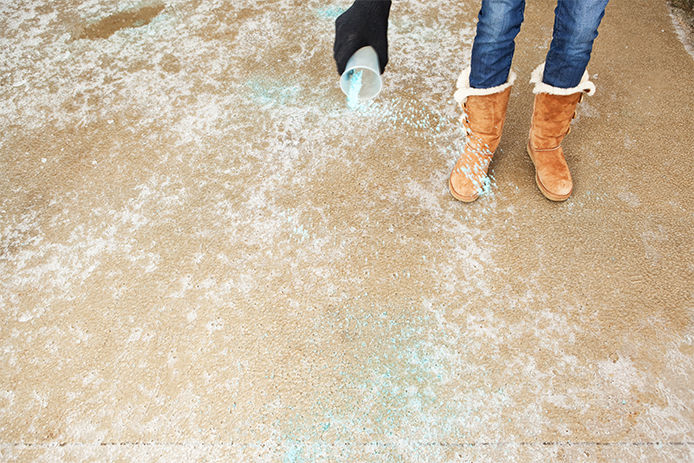Ice Melt 101: Everything You Need to Know

Ice and freezing temperatures can be a problem during the winter months. Potentially dangerous when accumulated on driveways, steps, and walkways, ice can cause slips, falls, and accidents that can put a real dent in your winter. Aside from shoveling, scraping, and sanding, ice melt is one of the most common ways to deal with slippery and icy conditions come winter. If your neighborhood gets icy in the colder months, perhaps using ice melt is the best approach for you. Here is everything you need to know about ice melt so you can be as prepared as possible for winter.
How Does Ice Melt Work?

Ice melting compounds work by lowering the freezing point of water. By attracting moisture and forming a liquid brine solution, these products can generate heat and melt the ice where applied. In short, ice melting products reduce the freezing temperatures by generating heat that can physically change and melt the ice around it.
Each type of ice melts works a little differently, so it’s important to know what kind you are using. That way, you can apply it correctly and understand what kind of results to expect. For example, the effectiveness of some types of ice melt depends on how cold it is outside: as temperatures drop, you may see its effectiveness decrease. And if you live in a region or climate that experiences extremely cold temperatures, products that include calcium chloride may work better.
Different Kinds of Ice Melt

Ice melt comes in different forms and can be made from different materials. Typically the active ingredients in ice melt are sodium chloride, calcium chloride, magnesium chloride, and calcium magnesium acetate. These chemicals all have different effects and implications that make some products better for certain needs or circumstances. For example, sodium chloride, also known as rock salt, offers traction and melts ice efficiently by lowering the freezing point of water but can also be corrosive and damaging to certain surfaces. On the other hand, calcium magnesium acetate is less corrosive than rock salt but is typically sold and applied in liquid form.
Is Ice Melt Bad for Concrete?

The short answer to this is yes. Some kinds of ice melt can be bad for concrete. Especially for newer or previously damaged concrete, some ice melts can corrode and further damage concrete surfaces. Sodium chloride, or rock salt, is an affordable and practical option for ice melt but is corrosive and may damage concrete, wood, and plants. Other ice melts, such as magnesium chloride, calcium magnesium acetate, and calcium chloride, tend to be more concrete-safe and less corrosive than rock salt.
Is Ice Melt Safe for Pets?

The short answer to this is no. Ice melts are not safe for pets. Even ice melt products that claim to be pet-safe are not considered completely safe for pets. The Animal Poison Control Center classifies all ice melt products as chemical irritants that can cause gastrointestinal symptoms and irritation to your pet’s paws and skin. If you have pets and are looking for a safer ice melt option for your fur babies, choose ice melts that are chloride and salt-free. Magnesium chloride is also considered a safer ice melt for your pets, whereas calcium chloride can burn skin and harm your pets. If you have pets at home, be sure to select an ice melt that won’t harm your furry family members.
How to Use Ice Melt

Different kinds of ice melt require different application methods. You could opt to buy pellets, granules, or liquid ice melt, and each one of these will need to be applied slightly differently. That said, there are a few general guidelines to follow when using ice melt.
First, it’s always a good idea to get a head start before the snow or ice starts to accumulate. When it begins to snow or become slick, apply ice melt to surfaces as soon as possible to prevent ice from forming. If there is snow accumulation, use a shovel, plow, or snow blower to remove the snow buildup before applying the ice melt. Apply the ice melt in a thin layer as close to the surface as possible. For dry products such as pellets, use a spreader to apply evenly. For liquid ice melt, use a clean garden sprayer, or watering can apply it evenly across surfaces. It’s always a good idea to wear gloves or other protective gear when applying to avoid irritating your skin. Because some ice melts can be corrosive and damaging, it’s good to remove excess ice melt once the ice has melted. Don’t shovel it into the grass or around plants. Instead, push it away from areas that can be damaged or dispose of the ice melt properly and according to the manufacturer’s instructions.
Ice melt is an excellent option for managing winter weather and icy conditions. Choose the right kind of ice melt for your needs to apply to driveways, steps, walkways, and other slippery surfaces to protect yourself from slipping and sliding. Always check the manufacturer’s instructions before using and read the application guidance and safety recommendations.
While do-it-yourself projects can be fun and fulfilling, there is always a potential for personal injury or property damage. We strongly suggest that any project beyond your abilities be left to licensed professionals such as electricians, plumbers, and carpenters. Any action you take upon the information on this website is strictly at your own risk, and we assume no responsibility or liability for the contents of this article.